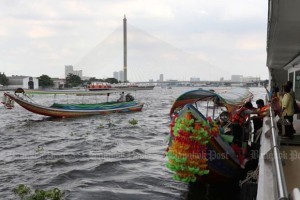King Mongkut Institute of Technology Ladkrabang (KMITL) has defended its proposal to build a 7 kilometre promenade along both sides of the Chao Phraya River.
The institute said on Wednesday that it had come in for a lot of criticism of the project by people who misunderstood the details.
KMITL lecturer in architecture Antika Sawadsri, the spokeswoman for the project, rejected information and photos that had painted the promenade in a negative light.
Ms Antika insisted an ongoing study of the project will give weight to non-engineering factors as well as community voices.
Her clarification came as opposition to the project escalated, with critics claiming it would infringe people’s rights. KMITL, with Khon Kaen University as its adviser, was contracted by City Hall on Feb 29 to conduct a 120-million-baht study of the promenade which would stretch for 7km along both sides of the river from Rama VII bridge to Pin Klao bridge.
Artistic impressions of the project and information that suggested the promenade would be 19.5m wide with a three-metre high wall was not a KMITL design, Ms Antika said.
She said experts who have been given seven months to complete a study, have not yet made any proposals, so presenting images and false information to communities at this stage was “highly unacceptable”, she said.
She said it also was not true that the project will be based predominantly on an engineering design. In its terms of construction the study team will comprise experts from various fields including architecture, hydraulics, environment and law, she said.
Above all, the study will heed the voice of the people, especially those near the construction areas, she said.
There are 31 communities along the proposed section of the river and the study team will visit each of them six times, she said, stressing all sides will take part in designing the project.
The riverside promenade, dubbed “The New Landmark of Thailand” was approved by the Prayut Chan-o-cha government in February last year as a recreational area as well as a flood barrier.
One of its primary aims is to ensure all people can better use riverside areas, she said. Only 28% of the river is accessible to the public as the rest is occupied or has been developed by private owners, Ms Anitika said.
Opponents have raised questions over the impact on cultural diversity along the banks if the construction, set to begin in October, goes ahead.
The National Human Rights Commission has been petitioned to consider the matter.
Source: http://m.bangkokpost.com/news/908136


